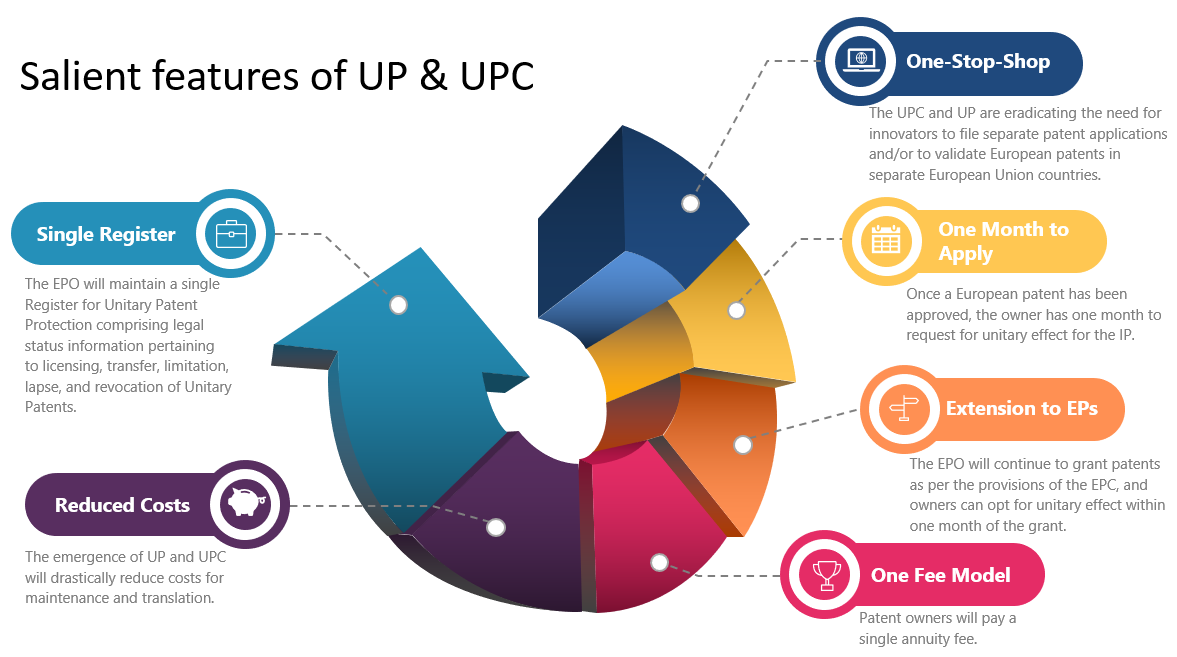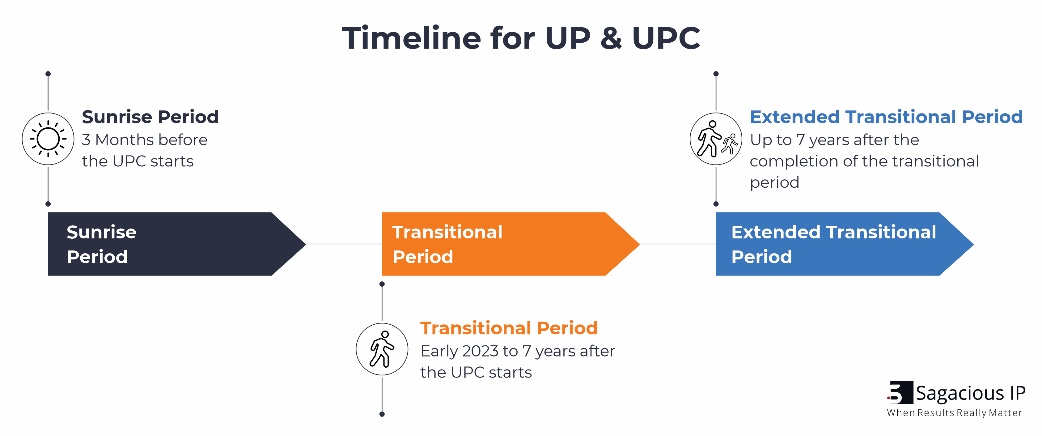Unitary Patent and Unified Patent Court: A Complete Guide
Although the IP landscape is forever evolving, the European patent landscape, in particular, is currently witnessing one of the biggest shifts in a long time. The advent of Unitary Patent (UP) and Unified Patent Court (UPC) in early 2023 is compelling companies operating in Europe to revisit their IP strategies. UP and UPC will open new avenues to manage cost and time, especially for patent-heavy businesses. While the new system seems quite promising on all fronts, it is anticipated to bring along its own set of challenges.
Bart van Wezenbeek – Sagacious IP’s Global Advisory Council Member and a former patent attorney – shares his thoughts on the new patent regime in Europe.

Table of Contents
So what is a Unitary Patent?
Quite simply, it is a legal title which will offer uniform protection to innovations with equal effect in all participating nations of the Agreement on Unified Patent Court (UPCA). The unitary effect will be available for all patents granted by the European Patent Office (EPO) as per the European Patent Convention (EPC). All Unitary Patents will enjoy a novel protection route – one parallel to national patents and traditional European patents (EPs). Besides saving huge costs, Unitary Patents will also reduce the administrative burdens for patent owners.
Unified Patent Court
The establishment of the Unitary Patent warrants the need for a single international jurisdiction to settle all disputes of validity and infringement. This is where Unified Patent Court comes into play. The UPC’s decision will be enforceable in all contracting member states, i.e., European Union members that have ratified the Agreement on Unified Patent Court. The special court will have the authority to decide on the matters of infringement actions, provisional measures and injunctions, revocation actions and counterclaims, private prior-use actions, actions for declaration of non-infringement, and actions for damages or compensation regarding UPs. However, the court will also have jurisdiction on (already existing and yet to be granted) traditional EPs, but of course, only for the member states that have ratified the Agreement. Thus, it will become a one-stop solution for patent applicants and owners seeking the resolution of their disputes and grievances.

Jurisdiction of Unified Patent Court
The UPC will enjoy a pan-European Union jurisdiction, extending to 24 member states of the European Union, with the exception of Croatia, Poland and Spain. Of these 24 countries, 17 have already ratified the UPC Agreement. The jurisdiction of the UPC is expected to expand in the coming years to encompass most of the European Union. Clearly, the cost-effectiveness of a Unitary Patent will expand as more countries of the European Union join the UPCA. However, it is worth noting that the unitary effect of any particular Unitary Patent will cover only those countries that had ratified the UPCA at the time of its issuance.
UP and UPC Enforcement Date
The entry-into-force date of the UPC will be known once Germany deposits its instrument of ratification. This will trigger the three-to-four-month “Sunrise Period,” after which the Unitary Patent and Unified Patent Court will come into effect. Although there is still no specific date, the court is expected to commence its operations in early 2023. Thus, patent applicants and owners should start exploring their options as per the new regime.
Will all European Patents be under UPC’s Jurisdiction?
As per the Unified Patent Court agreement rules, patent owners have the option to opt-out their current-style European patents from the jurisdiction of the UPC and remain under the jurisdiction of the national courts. With the current UPC Case Management System, patent owners must opt-out for every single European patent in their portfolio. The same rule applies to all applications pending before the European Patent Office.
The opt-out option is being looked at as an effective defensive strategy since revocation by a single authority (UPC) can render European patents with unitary effect revoked across a big chunk of the continent. However, patent owners going for the opt-out option will also miss reaping the benefits of Unitary Patents.
The Unified Patent Court will share jurisdiction with national courts till the end of a transitional period – seven years from the date of UPCA coming into effect. This transitional period may be extended once for a period of up to seven years. Post the expiry of this transitional period, only UPC will govern jurisdiction over European patents (either Unitary Patents or current-style European patents).

Is Sunrise Period Critical?
The sunrise period will provide a window for patent owners to file opt-out applications and remove their European patents and patent applications from the exclusive competence of the Unified Patent Court. The opt-out option will be available from the commencement of the sunrise period till the conclusion of the transitional period. The option is no longer available to a patent owner once an action has been brought against their patent or application before the UPC.
Benefits of UP and UPC
The benefits of the Unitary Patent system are explained below:
- Cost Saving: The annual cost of renewing a Unitary Patent is equivalent to the cost of renewing patents in four European countries. Thus, businesses seeking wide protection for their innovations can advantageously apply for unitary effect for their patents. Additionally, the new system will also help applicants save translation and validation costs.
- Pan-European Union Enforcement: The single court system eliminates scenarios with conflicting decisions from different judiciaries within the participating countries. Also, it makes it possible to seek relief at one spot despite infringement taking place in a range of separate territories.
- Quick Resolution: Patent infringement cases can stretch several years depending on the jurisdiction, discouraging companies from engaging in litigation. However, the Unified Patent Court aims to resolve cases within a year. Combined with the broad jurisdiction of the court, the quick resolution of cases will assure businesses regarding the protection of their IPs.
- Excellent for Small Businesses: Thevarious aspects of the new patent regime make it greatly beneficial for small and micro-businesses with limited resources at their disposal. Moreover, small and micro-businesses are also entitled to reduced court fees, adding to their delight.
- English as Primary Language: All Unitary Patents will have an English version. This is a great benefit for companies from English-speaking countries as this will save them translation costs. Further, in most, if not all, of the participating UPC local and central divisions, English may be used as the language of the proceedings.
- Simple Process: The emergence of the Unitary Patent and Unified Patent Court has certainly made things simple for applicants, plaintiffs as well as defendants.
Threats, Challenges and Opportunities Emerging with the New System
The new system is expected to pose threats, challenges, as well as opportunities. Let’s take a look at this for different stakeholders.
- For Litigators: The establishment of the UP and UPC will draw the attention of companies toward international litigators with specialization or expertise in international patent law. It will also persuade law firms to go international by limiting/eliminating the jurisdiction of national courts over European patents. Further, not only attorneys-at-law but also European Patent Attorneys may represent before the court.
- For Applicants: The Unitary Patent and Unified Patent Court have created several dilemmas for applicants as they must now answer several questions for each old and new EP in their portfolio. For instance, they must decide the extent of protection they need for their innovation, the markets they wish to explore, maintenance costs, strengths and weaknesses of their patents, their commercial value, and more.
- For Patent (Law) Firms: Patent firms must also adapt to the new regime. They must start with training their attorneys and paralegals regarding the latest patent system. Patent/law firms should also connect to and prepare a docketing system for the procedures before the UPC.
Final Thoughts
Years of efforts will soon come to fruition with the establishment of the Unitary Patent and Unified Patent Court. This tectonic shift in the European IP regime has its challenges as well as opportunities for businesses. Patent holders and innovators ought to start reanalyzing their patent strategies right away. Amongst the most critical tasks for companies is to decide whether they should go for unitary effect for their patent or stay with the current system. A further important task is to consider whether or not to submit opt-out requests. Thus, a thorough analysis of every EP in the portfolio is essential, based on business strategy as well as the impact of each individual patent. Sagacious IP can help your business prepare for the upcoming patent regime. Visit our Unitary Patent and Unified Patent Court Services page to learn about our expertise.
– The Editorial Team




